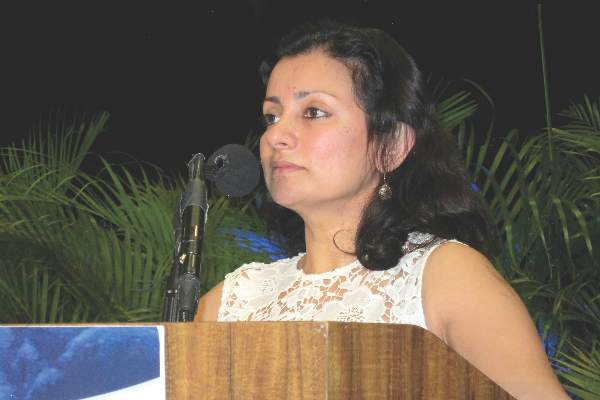EXPERT ANALYSIS FROM RWCS 2016
MAUI, HAWAII (FRONTLINE MEDICAL NEWS) – Oral mongersen shows promise of being “the Holy Grail” of inflammatory bowel disease (IBD) therapy if the promising phase II results are confirmed in phase III clinical trials, Dr. Uma Mahadevan said at the 2016 Rheumatology Winter Clinical Symposium.
This perfect drug for IBD would be something that’s effective, safe, and well tolerated; orally administered; shows long-term efficacy; and can be dosed as needed. Preliminary indications are that mongersen may check off those boxes, according to Dr. Mahadevan, professor of medicine and joint medical director of the Center for Colitis and Crohn’s Disease at the University of California, San Francisco.
An Italian double-blind, placebo-controlled, phase II study of mongersen in Crohn’s disease generated enormous attention among IBD patients and gastroenterologists, with reported day 15 clinical remission rates of 55% and 65% at 40 and 160 mg/day, respectively ( N Engl J Med. 2015 Mar 19;372:1104-13 ).
“We haven’t seen numbers like that in a Crohn’s trial since the very first Remicade [infliximab] trial. So there’s a lot of excitement about it. The study mechanics are a little suspect, but if the data in the current phase III trials are half as good, mongersen may be what we’re looking for,” Dr. Mahadevan said.
Mongersen is an oligonucleotide that inhibits ileal and colonic SMAD7, a protein that prevents transforming growth factor beta1–mediated suppression of inflammatory genes.
Why was a gastroenterologist providing an IBD update at a rheumatology conference? Dr. Mahadevan was invited in order to provide the conference’s annual “Outside the Box” feature, in which a nonrheumatologist expert shares the latest thinking about a disease relevant to rheumatology.
IBD fills the bill for several reasons. For one, many of the extraintestinal manifestations of IBD overlap with rheumatologic conditions. These include uveitis, arthritis, and arthralgias; osteopenia and osteoporosis; psoriasiform skin lesions; and thromboembolism. It’s not unusual for these extraintestinal manifestations to bring a patient to a nongastroenterologist before the diagnosis of IBD has been made.
Also, gastroenterologists and rheumatologists use a lot of the same drugs.
“The only drug gastroenterologists use for IBD that didn’t come from rheumatology first is vedolizumab [Entyvio],” she observed.
Ustekinumab (Stelara), which Dr. Mahadevan and other IBD experts have been using off-label for refractory Crohn’s disease with what she termed “very good” results, is expected to receive an Food and Drug Administration indication for Crohn’s disease by year’s end on the strength of impressive phase III data reported last fall.
“When approved, ustekinumab should be a first-line therapy, parallel to the TNF [tumor necrosis factor] inhibitors,” she predicted.
Another reason it’s worthwhile for rheumatologists to be up to date on IBD is that in many parts of the country, some gastroenterologists in community practice are uncomfortable using TNF inhibitors, which are now standard therapy for IBD. They may refer those patients to their local rheumatologist. But be advised: the dosing is very different from in rheumatology.
“For example, you start adalimumab [Humira] at 40 mg every other week for rheumatoid arthritis, psoriatic arthritis, or ankylosing spondylitis, but we [gastroenterologists] do a loading dose of four 40-mg injections on day 1, then 80 mg 2 weeks later, and then maintenance dosing at 40 mg every 2 weeks. Sometimes in our patient population you’re not going to get a response unless you use a high dose like that,” the gastroenterologist explained.
The incidence of IBD is climbing. It was estimated at 5-7 cases per 100,000 population in the late 1990s, but it’s now believed to be 7-12 per 100,000. The peak age of onset is still in 15- to 30-year-olds, but now physicians are seeing a strong second peak later in life, among individuals in their 60s and 70s. And while Caucasians and Ashkenazi Jews have traditionally been thought of as the groups at increased risk for IBD, treatment centers are now springing up in India, China, and other countries where IBD was formerly thought to be less common.
“What is happening? Is it that because of better medical care we’re now picking up more cases outside of North America and Europe? Or is it a change in the environment – the microbiome, the Westernized diet, pollution? We really don’t know. But this is where a lot of study is going,” according to Dr. Mahadevan.
Something nongastroenterologists need to know about the clinical care of IBD patients is that even though TNF inhibitors are now considered standard therapy for patients with more severe disease and these biologic agents are routinely used in IBD centers of excellence, their penetration into community practice has been slow. Although high-dose anti-TNF therapy is supposed to be employed in ulcerative colitis patients who are refractory to corticosteroid induction therapy or who are steroid dependent, it’s fairly common in some parts of the country for a patient to undergo colectomy without ever having received an anti-TNF biologic.
“If you’re in a surgery-dominated area, the surgeons were very influenced by a Cleveland Clinic paper that said patients who received infliximab had more complications after surgery. There were a lot of caveats to that paper, but colorectal surgeons don’t want you to use a TNF inhibitor if they feel the patient is going to surgery,” she said.
In addition to mongersen, other novel agents targeting new pathways in IBD include the oral Janus-associated kinase inhibitor tofacitinib (Xeljanz), under study for both ulcerative colitis and Crohn’s disease; ozanimod, an oral sphingosine 1–phosphate 1 and 5 receptor modulator in clinical trials for ulcerative colitis; and the humanized monoclonal antibody etrolizumab, a selective anti-integrin agent.
Dr. Mahadevan reported serving as a consultant to and/or research grant recipient from more than half a dozen pharmaceutical companies.



